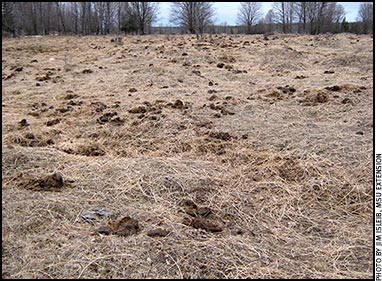Options for Managing Winter Manure Nutrients on Beef Farms
Depending on weather, available equipment and labor, beef farmers can choose the system that fits best.

Winter field feeding site using bale unrolling.
An overwintering, cow-calf beef herd produces manure — quite a lot of it. In one day, the average 1,250-pound (lb.) beef cow produces 75 lb. of manure and urine. This manure has approximately 0.31 lb. of nitrogen (not all of this is retained), 0.19 lb. of phosphate and 0.26 lb. of potassium. The feeding method beef farmers use to deal with this nutrient resource can have a positive impact on their forage and other crop production system.
Care should be taken to not overfeed in an area. Too great of an accumulation of wasted hay and manure can have a negative impact on forage yield next year.
There are four basic approaches to feeding the cow-calf herd during the winter:
- 1. Drylot feedyard. Drylot feeding consists of confining and feeding cattle in a drylot pen from October through April, or later. Cows are fed daily and nutrients accumulate in manure/straw pack throughout the winter.
- 2. In-field bale feeders. Bale feeders are placed in a field with frequent relocation of the feeders to better distribute manure and waste feed nutrients, and avoid sod damage.
- 3. Bale processing. Unroll or spread one large round bale at a time in a windrow on the ground or packed snow out in a field. The feeding site is moved each time to allow waste feed and manure to be evenly distributed across an area.
- 4. Bale grazing. Bales are set in place in a field in the fall. They can be prearranged by forage quality. Cattle are allowed gradual access to the bales on a planned schedule by moving temporary electric fencing.
What becomes of the nutrients from cattle manure and wasted feed under each of these systems? According to the University of Wisconsin Extension publication Guidelines for Applying Manure to Cropland and Pasture in Wisconsin, as much as 50% of the total nitrogen (N) and phosphorus (P) and 40% of the potassium (K) may be lost from manure on an open lot through volatilization, runoff or leaching. Up to 40% of the nitrogen and from 5% to 15% of the phosphorus and potassium may be lost during daily hauling and spreading. Much less of the nutrients are lost when cattle are winter-fed in the field.
Bart Lardner of the Canadian Western Beef Development Center conducted research on this issue in 2003-2005. His paper “Winter Feeding Beef Cows — Managing Manure Nutrients” states there was a definite difference in capture and utilization of manure nutrients between beef winter-feeding systems. His conclusions include:
“Significant benefits can result from winter-feeding beef cows on preselected sites due to increased capture and utilization of manure nutrients. Deposition of nutrients with cows versus machinery indicates more efficient cycling of nitrogen for subsequent pasture growth. In this study, economic calculations favored in-field feeding. Cow cost per day was lower for field feeding than wintering cows in drylot pens. Feed costs were similar between the systems, but field feeding had savings in machinery use and manure-handling costs. Results also indicate that benefits from wintering cows on feeding sites can be managed to reduce daily costs with minimal impacts on cow performance.”
In effect, the most desirable winter-feeding systems with regard to manure nutrient retention and recycling (in order of efficiency):
- bale grazing;
- bale processing; and
- drylot feeding.
There are certainly some cow-calf farmers who feed their herds during winter in drylot settings and do not scrape, haul and spread the accumulated manure in spring. This practice results in wasting manure nutrient resources and may present a situation posing risk to nearby surface and groundwater resources. Investment in machinery (e.g., manure spreader, bucket loader) to facilitate scraping, hauling and spreading drylot manure should be considered.

Editor’s Note: Jim Isleib is a crop production educator with Michigan State University Extension. Frank Wardynski is a ruminant educator with Michigan State University Extension.






